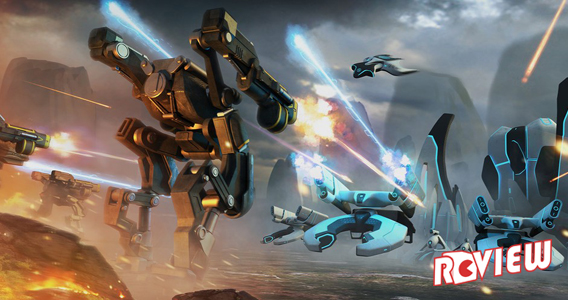
Out now is Grey Goo, and imaginative and clever real-time strategy title from Petroglyph Games. The title features a fifteen mission single player campaign, as well as online multiplayer in 1v2 and 2v2 varieties—as well as the option of custom offline AI matches.
The campaign of Grey Goo is broken into three acts, detailing the trials of its three core species (if an all-consuming molecular super-sludge can be called a species). Each mini-campaign runs five missions and connects to an over-arching story. The setting crafted by Petroglyph is familiar—seeing three races brought together by circumstance in a far off sector of space—but refreshing in its execution.
Featured within are the alien Beta, the futuristic humans, and the eponymous Goo—a self-replicating race of molecular machines. Interestingly, the Beta are presented as the most relatable, appearing as an underdog species in the early days of interstellar travel. Meanwhile, humanity has progressed so far as to become somewhat alien, and the eponymous Grey Goo, the fruits of humanity’s labor, even more alien still.
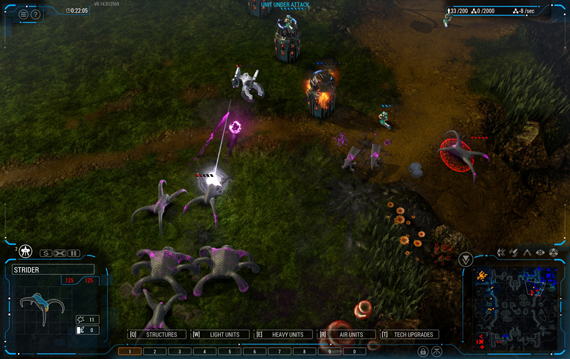
The story is told through a series of briefings and cut-scene interludes, each beautifully rendered and featuring stellar voice acting. The presentation of premise inflames the imagination, and if there is one criticism to be leveled against Grey Goo in this regard, it is that its ideas triggered in me a wild appetite, and there simply wasn’t enough content available to sate it. The standard RTS presentation of the campaign isn’t set up to deliver that depth of information—in 1998, the background, histories and minutia I crave might have been found in an illustrated manual. In Grey Goo’s case, the game would have benefited from a codex or lore journal; a place to digest some of the heavy science-fiction that forms the building blocks of the world.
Learning to play an RTS effectively is a very different animal from other genres, and I recognize that my moderate ability in StarCraft shouldn’t translate to (and could even hamper) the ease of learning the playstyle required to excel at Grey Goo. Even with that in mind, I would describe the difficulty curve on some of the campaign missions as daunting. Part of the problem is with the way Goo educates the player—that is to say, perhaps less than it should. I sometimes gleaned abilities or strategies after several frustrating attempts to complete a level that, upon discovering, made me feel simultaneously like a drooling idiot and a strategic genius. The sense of vindication when I finally completed those missions was palpable, but I came away with mixed feelings: I was angry at having sunk so much time into a frustrating scenario, but with my enhanced understanding I couldn’t help but be excited to play again.
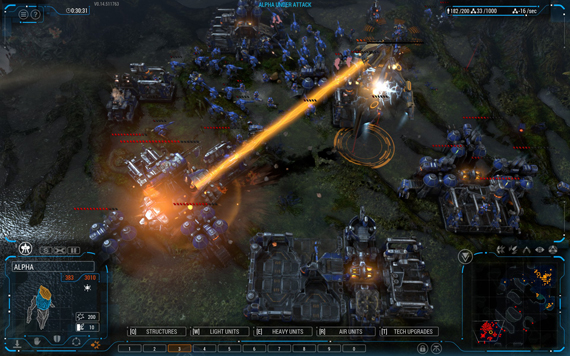
Everything a player needs to know about the races, tech trees, units and structures of Grey Goo is contained in the in-game encyclopedia, but the campaign itself provides little guidance on when various technology should be used, and how. For example, although a tool tip explained to me the function of a wall structure, I was knee deep in the penultimate mission of the Beta campaign before I realized how integral the wall was to an effective strategy with that species. Although one can certainly argue that the game gave me everything I needed to figure this out for myself, after spending so much time being obliterated for my ignorance, I came away feeling that a little reminder from an NPC would have drastically improved my experience.
Were Grey Goo any less than exceptional in the crafting of its three races, I might have abandoned it for these frustrations. Frankly, though, the core experience is simply too engaging to be ignored. Grey Goo scratches a particular itch with it’s focus on unique base building, and a de-emphasis on unit micro—when it’s not throwing a complete curve-ball in the form of the Goo.
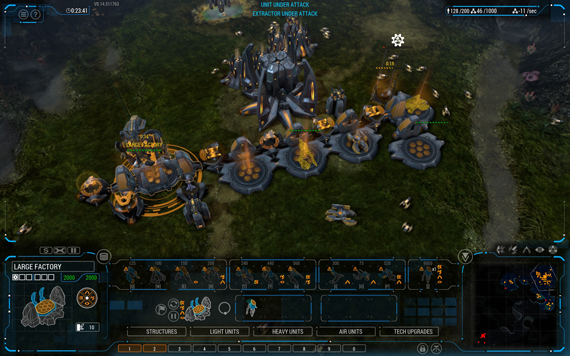
The humans and Beta both present unique paradigms for building and expanding. The Beta power structures through hubs that can be deployed anywhere on the battlefield that the player possesses sight. This means it’s easy to expand to new locations, but somewhat challenging to remain efficient—and protected. The Beta build powerful wall structures that can be mounted by offensive units, a critical strategy considering the tendency of a Beta base to become sprinkled across the map, where there may or may not be friendly units to provide protection.
Meanwhile, human bases must be innervated by a single, connected powergrid. This creates complications for expansion, because zigzagging powerlines must be laid across long distances to access faraway resources, effectively providing a breadcrumb trail back to the core of a human fortress. However, humanity’s automated defensive turrets are a far quicker and less complicated answer to raids than the more powerful Beta walls—when a key area comes under attack, a few turrets can be dropped into place in the surrounding power line structure, and then forgotten.
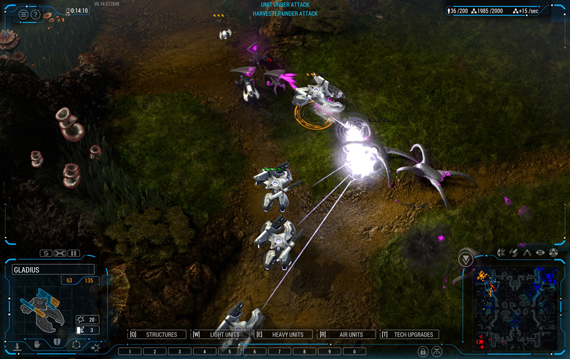
Finally, the Goo eschew basebuilding entirely, and instead present a fully mobile army. With no structures of any kind, Mothers—the sole production unit of the Goo—migrate between resource patches and collect the valuable Catalyst within. Increasing in size as they assimilate matter and energy (from both resources and enemies) the Mothers then split, with the new offspring becoming either specialized units or a new Mother. The premise of the self-replicating molecular machine that threatens to consume all life is wonderfully realized through this gameplay mechanic; the Goo doesn’t build, it consumes, it grows, and it multiplies.
The care and craft employed in distinguishing the three playstyles makes each a joy to discover and master. This alone is enough to recommend the title to RTS players looking for something refreshing.
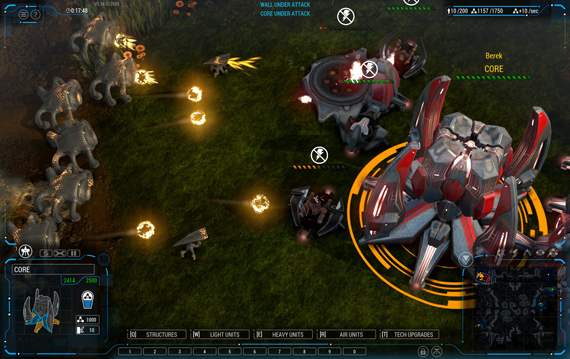
Still, it’s important to recognize that gameplay in such a title doesn’t exist in a void. The real test for Grey Goo is still ahead: waiting in the wings is the online community, who will test the mettle of the title by fine-tuning its machinery for maximum cruelty and efficiency. Grey Goo can’t compete with the likes of StarCraft on the featureset battleground; with only basic online modes available, it must sell itself to the community entirely on the grounds of its clever, unique design—and therein lies the challenge. If Grey Goo’s three races prove unbalanced once in the hands of the community—a community that sees all—then the legs of Grey Goo could be cut right out from under it.
It may be impossible to predict how the game will shake out once in the hands of players, but my hope is that proper post-release support will address any potential stumbling blocks in Grey Goo’s online infancy. Goo is a little rough around the edges, but there’s no denying the strength of the design within. In it’s current form, it is an exciting experiment, and I strongly recommend players take the opportunity to give it a chance.
Petroglyph Games
Publisher
Grey Box
System
Steam PC
Modes
Single-Player, Multiplayer
Release Date
January 23, 2015
Price
$49.99
*A Review copy was provided by the publisher for this review
